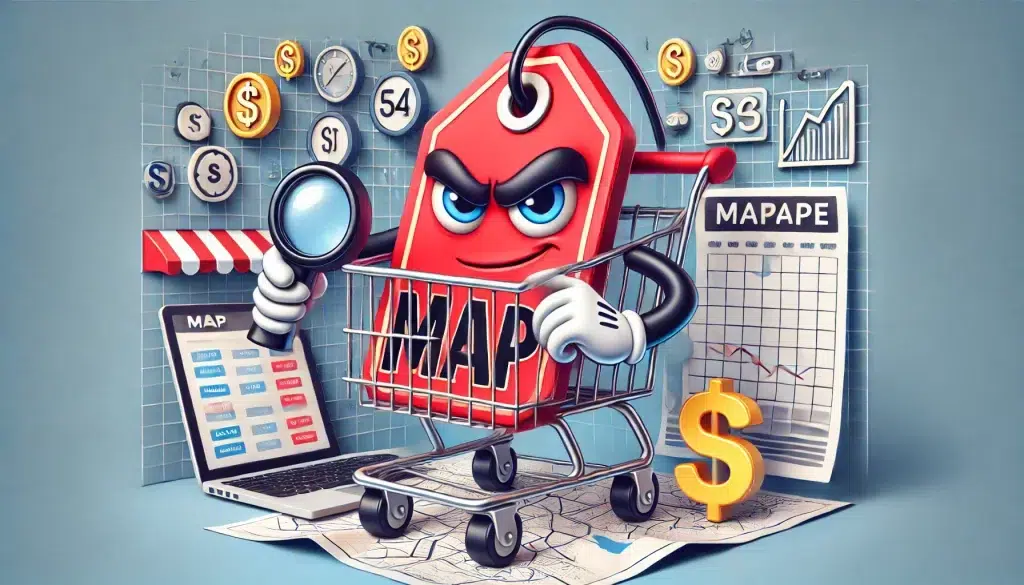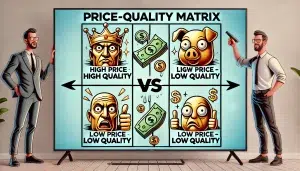
Table of Contents
- What is MAP?
- Key Points About MAP
- The History and Purpose of MAP
- How MAP Works
- MAP vs. MSRP: Understanding the Difference
- Legal Considerations of MAP Policies
- Benefits and Challenges of MAP
- Industries Where MAP is Commonly Used
- Implementing a MAP Policy: Best Practices
- MAP in the Digital Age
- How Pricefy Can Help You with MAP
- Conclusion
- Useful Links
What is MAP?
Minimum Advertised Price (MAP) is the lowest price at which a retailer agrees to advertise a manufacturer’s product. It’s important to note that MAP is not the same as the actual selling price; rather, it sets a floor for the advertised price of a product. Manufacturers implement MAP policies to maintain brand value, protect profit margins, and ensure fair competition among retailers.
Key Points About MAP
- MAP is set by the manufacturer, not the retailer
- It applies to advertised prices, not the final selling price
- MAP policies are agreements between manufacturers and retailers
- Violating MAP can result in penalties or loss of the right to sell the product
- MAP is legal in many countries but subject to certain restrictions
The History and Purpose of MAP
MAP policies emerged in the United States in the early 20th century as a way for manufacturers to maintain control over their brand image and pricing. The primary purposes of MAP include:
- Protecting brand value and perception
- Ensuring fair competition among retailers
- Maintaining profit margins for both manufacturers and retailers
- Supporting smaller retailers who can’t compete solely on price
According to a 2020 survey by Kaspien, 64% of brands use MAP policies to protect their products’ perceived value and ensure fair competition.
How MAP Works
MAP policies typically work as follows:
- The manufacturer sets a minimum advertised price for their product
- Retailers agree to the MAP policy as part of their distribution agreement
- Retailers can sell the product at any price but cannot advertise it below the MAP
- Advertising includes any public-facing price communication (e.g., website listings, flyers, TV ads)
- Manufacturers monitor adherence to MAP policies
- Violations may result in warnings, penalties, or termination of the distribution agreement
It’s worth noting that MAP policies don’t restrict the actual selling price. For example, a retailer could advertise a product at the MAP but offer additional discounts at checkout or through private communications with customers.
MAP vs. MSRP: Understanding the Difference
While often confused, MAP and MSRP (Manufacturer’s Suggested Retail Price) are distinct concepts:
MAP (Minimum Advertised Price)
- Sets the lowest price at which a product can be advertised
- Is part of an agreement between manufacturer and retailer
- Applies only to advertised prices, not final selling prices
- Often lower than MSRP
MSRP (Manufacturer’s Suggested Retail Price)
- Suggests a retail price for the product
- Is not binding; retailers can sell above or below this price
- Serves as a reference point for consumers
- Typically higher than MAP
A 2019 study by the University of Chicago found that products with MAP policies had prices 10% higher on average compared to similar products without such policies.
Legal Considerations of MAP Policies
The legality of MAP policies varies by jurisdiction:
- In the United States, MAP policies are generally legal if implemented correctly
- The Supreme Court’s 2007 Leegin decision removed the blanket prohibition on minimum resale price maintenance
- MAP policies must be unilateral (set by the manufacturer) and not the result of agreements between retailers
- In the European Union, MAP policies are generally considered a form of resale price maintenance and are prohibited
- Many other countries have their own specific regulations regarding MAP
Benefits and Challenges of MAP
Benefits:
- Protects brand value and perception
- Ensures fair competition among retailers
- Maintains profit margins for manufacturers and retailers
- Supports smaller retailers and brick-and-mortar stores
Challenges:
- Can be difficult to enforce, especially online
- May lead to higher prices for consumers
- Can be complex to implement and manage
- May face legal scrutiny in some jurisdictions
Industries Where MAP is Commonly Used
MAP policies are prevalent in various industries, including:
- Consumer electronics
- Luxury goods
- Sporting goods
- Automotive parts
- Home appliances
- Musical instruments
A 2021 report by Vorys eControl found that 77% of manufacturers in these industries use MAP policies to protect their brand and support their distribution networks.
Implementing a MAP Policy: Best Practices
To implement an effective MAP policy, consider the following steps:
- Consult with legal counsel to ensure compliance with local laws
- Clearly define the policy, including consequences for violations
- Communicate the policy to all retailers and obtain written agreement
- Establish a system for monitoring and enforcing the policy
- Apply the policy consistently across all retailers
- Regularly review and update the policy as needed
MAP in the Digital Age
The rise of e-commerce has significantly impacted MAP policies:
- Online marketplaces make it easier for retailers to violate MAP
- Price comparison tools increase pressure on retailers to offer lower prices
- Some retailers use creative methods to circumvent MAP (e.g., “see price in cart”)
- Manufacturers must adapt their policies and enforcement strategies for the digital landscape
A 2022 study by Forrester Research found that 68% of manufacturers reported increased difficulty in enforcing MAP policies due to e-commerce growth.
How Pricefy Can Help You with MAP
Pricefy offers powerful tools to help manufacturers and brands effectively manage and enforce their MAP policies:
- Automated MAP Monitoring: Pricefy can continuously scan online marketplaces and retailer websites to detect MAP violations quickly.
- Real-time Alerts: Receive instant notifications when a retailer advertises a product below the MAP, allowing for prompt action.
- Comprehensive Reporting: Generate detailed reports on MAP compliance across your entire distribution network, helping you identify trends and problematic retailers.
- Historical Data Analysis: Access historical pricing data to track long-term compliance and identify seasonal trends or patterns in MAP violations.
- Customizable Violation Thresholds: Set specific thresholds for MAP violations, allowing for flexibility in enforcement based on the severity or frequency of infractions.
- Automated Communication: Streamline the process of notifying retailers about MAP violations through automated email alerts or reports.
- Multi-channel Monitoring: Track MAP compliance across various sales channels, including major e-commerce platforms, individual retailer websites, and even print advertisements.
- Integration with MSRP Tracking: Compare MAP adherence with MSRP to gain a comprehensive view of your product’s pricing landscape.
By leveraging Pricefy’s capabilities, manufacturers can more effectively enforce their MAP policies, maintain brand value, and ensure fair competition among their retail partners. This automated approach saves time and resources while providing the data-driven insights needed to make informed decisions about pricing strategies and policy enforcement.
Useful Links
- Federal Trade Commission – Manufacturer-imposed Requirements
- Harvard Business Review – The Good-Better-Best Approach to Pricing
- National Law Review – Antitrust Risk and MAP Policies in the E-Commerce Age
- MIT Sloan Management Review – Is It Time to Rethink Your Pricing Strategy?
- U.S. Department of Justice – Antitrust Division: Price Fixing, Bid Rigging, and Market Allocation Schemes
Conclusion
Minimum Advertised Price (MAP) policies play a crucial role in modern retail strategies, balancing the interests of manufacturers, retailers, and consumers. Key takeaways include:
- MAP sets the lowest advertised price, not the selling price
- It helps maintain brand value and ensures fair competition
- MAP is legal in many jurisdictions but subject to specific regulations
- Implementing and enforcing MAP can be challenging, especially in the digital age
- Tools like Pricefy can help manage and enforce MAP policies effectively
As the retail landscape continues to evolve, manufacturers and retailers must stay informed about MAP policies and adapt their strategies accordingly to thrive in a competitive market.




